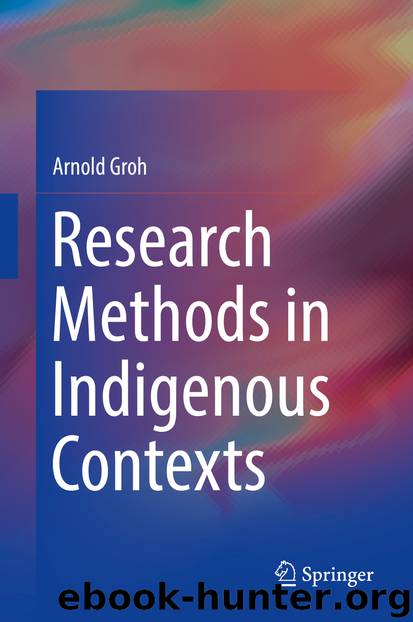Research Methods in Indigenous Contexts by Arnold Groh

Author:Arnold Groh
Language: eng
Format: epub
Publisher: Springer International Publishing, Cham
3.4.4 Objectivity
The procedures, which are applied in a study to determine the characteristics of interest, should yield unambiguous results. The findings must really and fully pertain to the issue, or object, of the investigation. Furthermore, procedures should function independently of the question, which researcher carries out the study. Different researchers must come to the same results, when they apply the same methods. Objectivity is fully given, when the researcher has no influence on the results. Thus, objectivity can be understood as being contrasting to subjectivity.
As subjectivity refers to bias that comes to bear in the study due to the researchers’ feelings, attitudes, preferences and disapprovals, such influence would debilitate the results. Objectivity of research , on the contrary, is the condition of being unbiased and without any of these subjective influences. Objectivity is indispensable for any scientific study (Scert Kerala 2016). It is clear that researchers cannot reach total objectivity, but this ascertainment should never be taken as an excuse, and we should always do our best that our studies are as objective as possible.
For field research in indigenous contexts, this implies the necessity to reduce any influence, which we as persons could have, and since the aspect of culture plays a pivotal role, special weight has to be put on disabling all cultural influence or at least to reduce it to a minimum. At the same time, it has to be taken into consideration that the indigenous peoples visited behave in particular ways, just because you are there; otherwise, they would behave differently. People behaving in other ways than usual due to the fact that they are being investigated is a well-known effect from social psychology. They might put on clothes or cover their bodies partially because they don’t want to be seen as being primitive. Since this is an effect of dominance and feelings of inferiority, it should be counterbalanced by the researchers. Concrete examples are given in the next chapter of this book (Sects. 4.3 and 4.5.1). But it also happens that parents tell their unmarried daughters to stay in the hut, as long as there are visitors in the village, or even all young women are confined to either the hut or to fieldwork, so that you only see them very briefly, at the best, when the pass by. Furthermore, as an honour to the guests, it could happen that indigenous people put on some decoration, which they usually wouldn’t.
By the way, one also has to be thoughtful with regard to the different ways feather headdresses are regarded. It once happened that a man, while we were in a Dani village, tangled up a feather of his headdress in twigs, so that it fell off. He kept on lamenting about this, and my automatic reaction was that I thought, so what, why does he make such a big deal about this feather? But then, it became clear to me that this mishap was at least comparable to a car body damage, if that would be an expensive car.
Download
This site does not store any files on its server. We only index and link to content provided by other sites. Please contact the content providers to delete copyright contents if any and email us, we'll remove relevant links or contents immediately.
Rewire Your Anxious Brain by Catherine M. Pittman(18479)
Talking to Strangers by Malcolm Gladwell(13121)
The Art of Thinking Clearly by Rolf Dobelli(10125)
Mindhunter: Inside the FBI's Elite Serial Crime Unit by John E. Douglas & Mark Olshaker(9093)
Becoming Supernatural by Dr. Joe Dispenza(8026)
Change Your Questions, Change Your Life by Marilee Adams(7551)
The Road Less Traveled by M. Scott Peck(7465)
Nudge - Improving Decisions about Health, Wealth, and Happiness by Thaler Sunstein(7450)
The Lost Art of Listening by Michael P. Nichols(7353)
Mastermind: How to Think Like Sherlock Holmes by Maria Konnikova(7149)
Enlightenment Now: The Case for Reason, Science, Humanism, and Progress by Steven Pinker(7078)
Win Bigly by Scott Adams(7026)
The Way of Zen by Alan W. Watts(6442)
Daring Greatly by Brene Brown(6359)
Big Magic: Creative Living Beyond Fear by Elizabeth Gilbert(5545)
Grit by Angela Duckworth(5442)
Ego Is the Enemy by Ryan Holiday(5217)
Men In Love by Nancy Friday(5101)
Altered Sensations by David Pantalony(4996)
